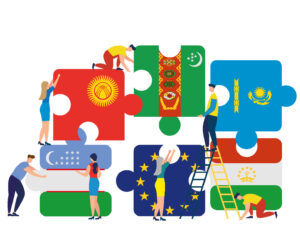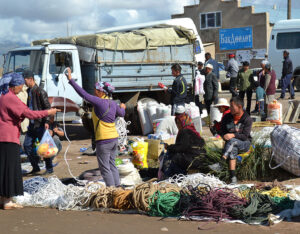Is the EU-Central Asia Strategy running out of steam?

Download “Is the EU-Central Asia Strategy running out of steam?”
EUCAM-Policy-Brief-17.pdf – Downloaded 362 times – 586.12 KBThe European Union’s Strategy for a New Partnership with Central Asia is approaching its fourth year of implementation.(1) In that time the EU has placed its relationship with Central Asia on a more structured footing through the establishment of several formal initiatives designed to support seven engagement priorities in the region.(2) The EU Development Cooperation Instrument (DCI) has allocated €321 million to support the Strategy between 2011 and 2013.(3) Direct contacts between European officials and political leaders from the region, conducted in both Europe and Central Asia, are at unprecedented levels. Although progress has been made in building dialogue and in furthering engagement in certain defined areas, the limitations of the strategy are increasingly obvious. The Joint (Commission and Council) Progress Report (JPR)(4) on the implementation of the EU Strategy for Central Asia, released in June 2010, acknowledged that improvements are necessary, although clear action or solutions are not proposed.
The core of the problem is a (possibly understandable) deficit within the EU in defining and articulating its interests in the region. The EU has not visibly integrated, or even reconciled, its various agendas: normative (human rights, good governance, cultural dialogue), technical (education, environment, economic development) and interest-based (energy, security). As the unfolding events in the Middle East have vividly illustrated, reliance on inherently undemocratic elites to deliver securityfocused pillars of the relationship can potentially undermine both the credibility and delivery of the normative elements of the EU’s agenda. Compounding this dilemma is the lack of visibility and impact of the Strategy and the tangible lack of progress in building regional cooperation. Many of the leaders in the region have a history of hostile personal relations, and the region’s economies, although in many respects interdependent, are not geared to cooperation either in terms of resource usage or broader economic development. Moreover, there is clear scope for improvement in developing both internal EU coordination and engagement with other international donors and critical European and regional stakeholders.
To its credit, the JPR is objective and transparent in recognising these deficits, but overplays the importance of the human rights dialogues where tangible progress at ‘ground level’ has been negligible. The JPR identified specific areas for reinforced engagement: human rights; rule of law and democracy; security; water and energy; and security cooperation over Afghanistan. However, there are few defined and measurable objectives in delivering progress and the JPR stops short of:
- firstly, fundamentally re-evaluating whether the seven priorities are sustainable;
- secondly, evaluating the likelihood of available resources realistically matching the strategy’s objectives; and
- thirdly, addressing the EU’s limited leverage on, and interest in, Central Asia’s most urgent security challenges.
This brief argues that the driving force of the EU engagement with Central Asia should be based on a closer link between security and development. Engagement in this broad field should be underpinned by a values based approach that seeks to promote reform on human rights, rule of law, governance and democracy more explicitly.
The momentous changes sweeping across the Middle East and North Africa have demonstrated that even the most apparently durable authoritarian regimes are vulnerable to sudden political shocks. The instability seen in Kyrgyzstan during 2010, although stemming from a combination of very country-specific vulnerabilities, illustrates that Central Asia is not immune to violent political change. The EU has to be careful, in US President Barack Obama’s words, not to be “on the wrong side of history”. In all of the Central Asian states, sudden leadership change is likely to create a political vacuum within which ethnic, regional and economic grievances could arise in unpredictable ways.
Three challenges
So, where does the EU go in the next (2011-13) phase of its Strategy? At present, the Strategy suffers from three shortcomings that must be remedied if the EU is to effectively define its ‘key interests, means and constraints in the quickly evolving regional context as well as ensuing priorities and expectations’.(5)
First, for all the Strategy’s many priorities and interests, it is, as noted, only backed by €321 million in the period 2011- 2013.(6) This is approximately €20 million per country per year, a modest amount compared to assistance received by countries in Europe’s neighbourhood. We do not argue that Central Asia has a higher priority than other regions and should receive more funding but we do argue that the current list of priorities is too broad and that funding is spread over too many areas of interest to have a sustainable impact. In short, tough choices need to be made about where the EU directs its resources. Meanwhile there is still a chance that committed funding will be redirected to other regions which would send the wrong signal to Central Asia and affect the EU’s reputation as it would be regarded as fire fighting instead of committing to structural assistance.
We argue here for increased project funding linking security to development. This is a broad field since security and development can mean almost anything. However, linked together, and taking good governance, rule of law, democracy and human rights into account, it would be possible for the EU to increasingly devote attention to Security Sector Reform (SSR) which is an area that comprises all institutions and actors involved on security matters; from military to police and from the ministries to the parliament and civil society groupings. Of course Central Asian regimes leave little room to engage on all facets of SSR but there might be room for working on good governance initiatives that link to police reform or (less sensitive) disaster response mechanisms. The EU should also use its limited leverage to address more sensitive topics in the security and governance fields with Central Asian leaderships. The little and ad hoc SSR project funding that does exist in Central Asia mostly comes from European governments which is insufficient. A coordinated EU approach that goes beyond SSR and selects and discusses a portfolio of projects with Central Asia’s republics might actually have an impact and help clarify Europe’s role of stability and security in Central Asia.
Second, the EU is divided over its approach to the authoritarian regimes and leaders of Central Asia. Human rights dialogues have increasingly become separated from other policy discussions with Central Asia. The EU seems, for instance, to be more flexible towards Turkmenistan whose gas reserves may be critical to the feasibility of Southern Corridor energy transit projects. The question is not only about a choice between energy and values but goes deeper into Brussels’ dealings with the region.
The EU’s approach to Uzbekistan is an instructive case. EU sanctions, imposed following the violent suppression of an uprising in the eastern Uzbek city of Andijan in May 2005, were lifted in October 2009. However, virtually no substantive reforms have taken place in the field of human rights, good governance, rule of law and democratisation. Meanwhile, relations between Tashkent and Brussels have not improved nor has there been a substantial growth in trade and energy ties. In January 2011, President Islam Karimov visited Brussels to meet with EU and NATO officials but the Belgian authorities, the EU and NATO all denied having sent the invitation which deeply divided the EU. Karimov initially flew in to London but was pointedly not received by any UK government official. EU Commission President Barroso welcomed Karimov while Council President Van Rompuy categorically refused to meet with him.
Ultimately, the visit of Karimov, which was poorly managed, reinforced the reality that EU-Uzbekistan relations remain insubstantial with little immediate prospect of further improvement. It is logical to conclude that Karimov’s presence in Brussels could be interpreted as recognition for Uzbekistan’s logistical cooperation in NATO’s Afghanistan campaign. It demonstrated that member states are deeply divided over their engagement with the Uzbek government, that within EU structures there are also divergent views between Commission and Council and that, ultimately, NATO’s security imperatives in Afghanistan, however viewed, have shaped engagement with Uzbekistan. This is underscored by the noticeably high profile accorded to security cooperation over Afghanistan in the 2010 JPR.
Third, while the underlying rationale of the Strategy is increasingly geared towards security the EU can expect little from this unless it formulates more clearly what objectives it hopes to achieve and how to achieve them. Most EU activities in the security field are indirect, focusing on governance projects and through engagement with Central Asian leaders and sometimes with civil society or officials on a local level. The Border Management Programme in Central Asia (BOMCA) is the only direct securityrelated work that is financed by the EU (though implemented by the UN Development Programme).
The violent episodes in Kyrgyzstan between April and June 2010 showed that the EU has neither the mechanisms to act if necessary nor the will to become directly involved in complex regional emergencies. However, this also applies to China, the US and regional security organisations such as Collective Security Treaty Organisation (CSTO) and the Organisation for Security and Cooperation in Europe (OSCE), while Russia probably had the means to quickly intervene but also chose to show restraint. Next to national and regional security dilemmas and threats there is the war in Afghanistan where the EU hopes that Central Asian states go beyond allowing NATO to ship supplies through its territories. It is however unclear what Central Asian states could contribute; if they are willing and capable to contribute; and how the EU can support the countries in making them into genuine partners concerning Afghanistan.
The EU’s core task should be to sort out its priorities for the region and the region’s own priority issues and try to bind them more systematically, and also direct resources to areas where the impact will be greatest for both parties. Good governance in the security sector might be taken up as one of the priorities; discussing change with the Central Asian leaderships but also through a bottom-up approach in working with local authorities and civil societies (however limited their presence might be) in addressing issues such as reform of the police, prisons, disaster preparedness mechanisms and possible extension of the BOMCA programme. The EU Initiative on Rule of Law – coordinated by France and Germany – could serve as one of the frameworks in which Europe addresses security-development issues in a values-based approach. This regional initiative is gaining interest from additional EU members – for instance through financial support from Finland – hopefully to be followed by others. A primary task is to work for the interests of Central Asians, where they are detached from those of the region’s leaders, and this will mean identifying the EU’s potential for leverage and a willingness to use it if appropriate.
Taking up regional security
Central Asia faces a host of security challenges that include drug trafficking, human trafficking, organised crime and terrorism, in addition to the external ‘overspill’ threat posed by instability in Afghanistan and possible military action against Iran. The region also has specific intra-regional threats, notably inter-state conflict potential between upstream and downstream states arising from diversion of scarce water resources for power generation and irrigation purposes. At the national level, the poorest Central Asian republics face the threat of instability due to a combination of deficient governance, endemic official corruption, and downward pressure on household incomes, exacerbated by higher food prices and falling remittances following the onset of the global financial crisis.(7) While the socalled ‘Arab Spring’ of 2011 is the culmination of region-specific drivers, many of the underlying structural causes are replicated in Central Asia.
Tangible progress in the area of regional cooperation has been in short supply and there are three reasons for this failure. First, the EU’s aspirations are so broad-ranging and general that they work against the focused pursuit of achievable and measurable objectives. Second, the demands of NATO’s campaign in Afghanistan have served to effectively de-link the security and governance agendas, demonstrated above in the disorganised handling of President Karimov’s visit to Brussels. Third, there is an absence of coordinated will on the EU’s part to understand and engage with the complex realities of Central Asia’s security deficits, most obviously in the initiatives designed to counter narco-trafficking described below.
Much of the activity undertaken so far under the Strategy, from political dialogue to assistance programmes, forms part of the security ‘basket’. The French and Swedish EU presidencies organised high-level security conferences in 2008 and 2009 while EU Special Representative Pierre Morel regularly discusses security issues with the region’s leaders. On an operational level, the EU has two projects – the Border Management programme in Central Asia (BOMCA) and the Central Asia Drug Action Programme (CADAP) – both of which predate the Strategy. The Central Asia Regional Information and Coordination Centre (CARICC), which has been established to combat the illicit trafficking of narcotics and their sources, is also supported by the EU.
BOMCA involves practical capacity building to develop border management strategies, including training of border guards and infrastructural improvements, particularly along the porous Tajik-Afghan border where narco-trafficking represents a significant ‘soft’ security threat. However, there is credible evidence of direct involvement by leading state officials in the narco-trafficking trade, including members of the family and government of former Kyrgyz President Kurmanbek Bakiyev.(8) Persistent allegations continue to be made that high-ranking Tajik officials are also implicated in smuggling.(9) Interestingly, President Imomali Rahmon’s 23 year old son, Rustami Imomali, was appointed to head the anti-drug trafficking department of the Customs Committee in March 2011.(10) There is thus a real risk that the EU’s narcotics control efforts are being channelled by Central Asian government officials to eliminate rivals rather than the problem itself. In this instance, the integration of the human security dimension, most obviously in the promotion of good governance and the rule of law, with the broader security agenda has not been satisfactorily developed.
So, how does the EU untangle these dilemmas? First, security in Central Asia is an issue around which the interests of all EU member states converge. This is rare in the area of EU external relations and represents an important start. Second, there are external threats, notably in Afghanistan, where the interests of the EU and Central Asia undoubtedly converge. In this, the EU must recognise that the leverage is not all one way. It is arguably even less in the interests of Uzbekistan for Afghanistan to be controlled by the Taliban than it is for EU member-states. The EU should not, therefore, seek to ‘reward’ Uzbekistan for security cooperation with NATO-led forces in Afghanistan by going easy on human rights issues. Without Coalition assistance, Uzbekistan would be on the front line. President Karimov knows this and has very few alternatives to working with NATO. As a consequence, there is perhaps more opportunity than is acknowledged to approach security cooperation in a broader sense with Uzbekistan, incorporating integrated border management, regional cooperation initiatives and security sector reform.
Finally, the EU should be focusing its efforts more closely on where it can make most difference in countering intra-regional security threats. The difficult issue of water and environmental protection provides a clear opportunity to join up security aspirations, the promotion of greater regional cooperation and the work begun by the EU Water Initiative, currently being coordinated by Italy and the Commission. The EU should learn from the successes and failures of previous irrigation projects undertaken by Mercy Corps, the Swiss Agency for Development and Cooperation (SDS) and the UNDP (11) , but be unafraid to exercise its convening power to help resolve issues fairly by the states themselves. It could build in poverty reduction strategies and maintain awareness of sensitivities surrounding the use of contested territories and the mobilisation of ethnicity by different parties to suit their interests. To the EU’s credit it has been able to get the five Central Asian republics around the table in the Water Initiative, which is an accomplishment in itself.
Overall, for the EU to have a greater impact, it must interweave the strands of its security objectives with other aspects of the regional strategy, notably those concerning regional cooperation and improved governance, and focus on the areas where it can make a material difference, rather than areas where dialogue occurs but little in the way of action emerges.
Conclusion
It is not too late for the EU’s Strategy for Central Asia to have a greater impact. The easy route between now and 2013 would be to fall back on high-level seminars and dialogues where both parties go through the motions, and to fund numerous incoherent projects that make little practical difference to Central Asians, fail to further the EU’s essential interests and values, and do not represent value for money.
To avoid that fate, the EU must realise that it should operate in a lean and direct way, focusing resources on critical issues where it might make a difference. The overarching seven priorities of the Strategy remain valid but choices need to be on where to back up interests with substantial funding. Programming underpinned by ‘values’ and which links (human) security to development would be a way to prioritise funding through technical assistance and projects with local and national authorities plus civil society.
The interests of both Europeans and Central Asians largely coincide: economic development and greater security (in Central Asians’ case from both internal and external threats) to the benefit of both. The EU’s Strategy should start from this shared standpoint, while recognising the immediate disjuncture between perceptions of what constitutes ‘security’. Central Asian political elites interpret security principally as regime security, while for the EU the term encompasses a human dimension that involves the right to free association, worship and impartial rule of law, underpinned by good governance. The EU has been content to focus its initiatives in areas where the definition can be shared, such as on border management and halting the narcotics trade , although even this, as noted above, can be distorted by possible local political involvement or acquiescence in drug trafficking. European representatives should not shy away from addressing Central Asia’s security shortcomings, both in terms of human security as well as in governance and state security. On the other hand it should then be able to offer concrete assistance.
Thus, for a more comprehensive approach to take root, the EU must now articulate its objectives by clearly linking the different strands of its approach, and focus on the areas where it can produce most benefit both to the region’s people and in furtherance of its own regional strategy.
- The European Union and Central Asia. Strategy for a New Partnership’, European Council (Brussels, June 2007), http://www.eeas.europa.eu/central_asia/docs/2010_strategy_eu_centralasia_en.pdf
- Human rights, the rule of law, good governance and democratisation; youth and education; economic development, trade and investment; strengthening energy and transport links; environmental sustainability and water; combating common threats and challenges; and inter-cultural dialogue.
- Central Asia DCI Indicative Programme (2011-2013). http://eeas.europa.eu/central_asia/docs/2010_ca_mtr_en.pdf
- Joint Progress Report on the implementation of the EU Strategy for Central Asia (Brussels, 28 June 2010), http://register.consilium.europa.eu/pdf/en/10/st11/st11402.en10.pdf#page=2
- Joint Progress Report on the implementation of the EU Strategy for Central Asia.
- This amount is provided through the DCI. A roughly equal amount is provided through several other European funding mechanisms such as EIDHR or the Instrument for stability; by European financial institutions (EIB and EBRD) and through national funding by EU member states. For an overview of the allocation of the €719 million see: European Community Regional Strategy Paper for assistance to Central Asia for the period 2007–13, http://ec.europa.eu/external_relations/central_asia/rsp/07_13_en.pdf
- On the impact of rising food prices, see ‘Central Asian regimes brace for impact of global food crisis‘, Sayara Ma-Shan-Lo, AFP, 19 February 2011.
- For the involvement of Bakiyev’s circle in narco-trafficking see ’The Pogroms in Kyrgyzstan’, International Crisis Group Report No. 193, 23 August 2010, http://www.crisisgroup.org/en/regions/asia/central-asia/kyrgyzstan/193-the-pogroms-in-kyrgyzstan.aspx
- The case of official collusion in narco-trafficking by senior officials in Tajikistan’s government is covered in Letizia Paoli, Irina Rabkov, Victoria A. Greenfield and Peter Reuter: ‘Tajikistan: The Rise of a Narco-State’, Journal of Drug Issues, 37 (4), 2007, pp.951-980.
- “The President promotes his son to new customs post”, Economist Intelligence Unit, 17 March 2011.
- For a critique of these projects, see Christine Bichsel, Conflict Transformation in Central Asia: Irrigation Disputes in the Ferghana Valley (Routledge: Abingdon), 2009.







